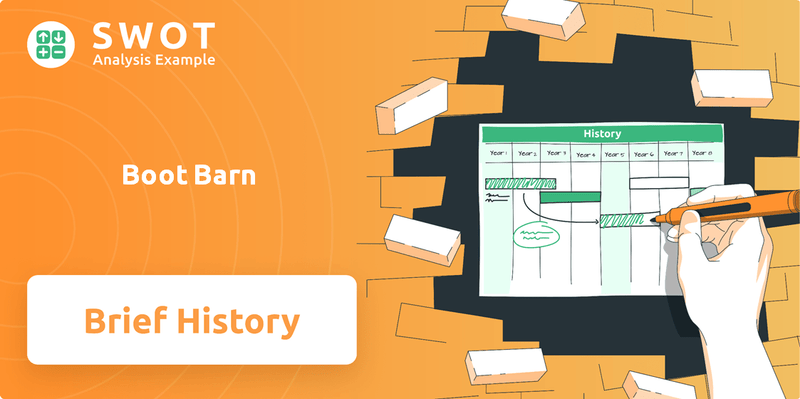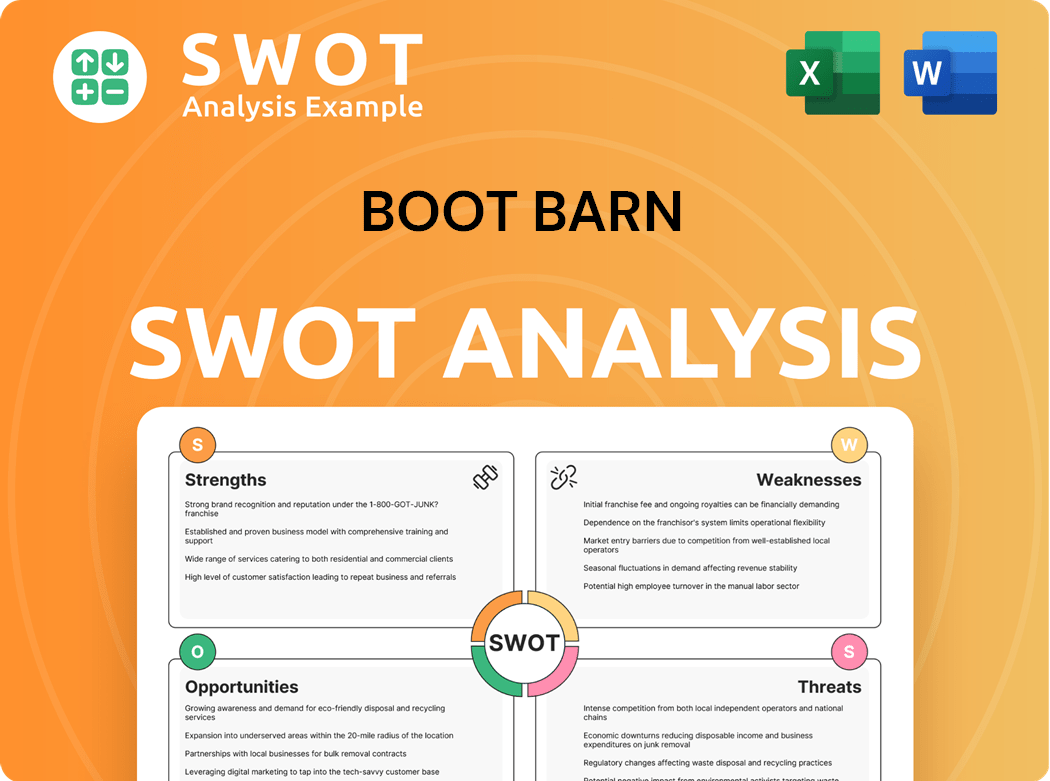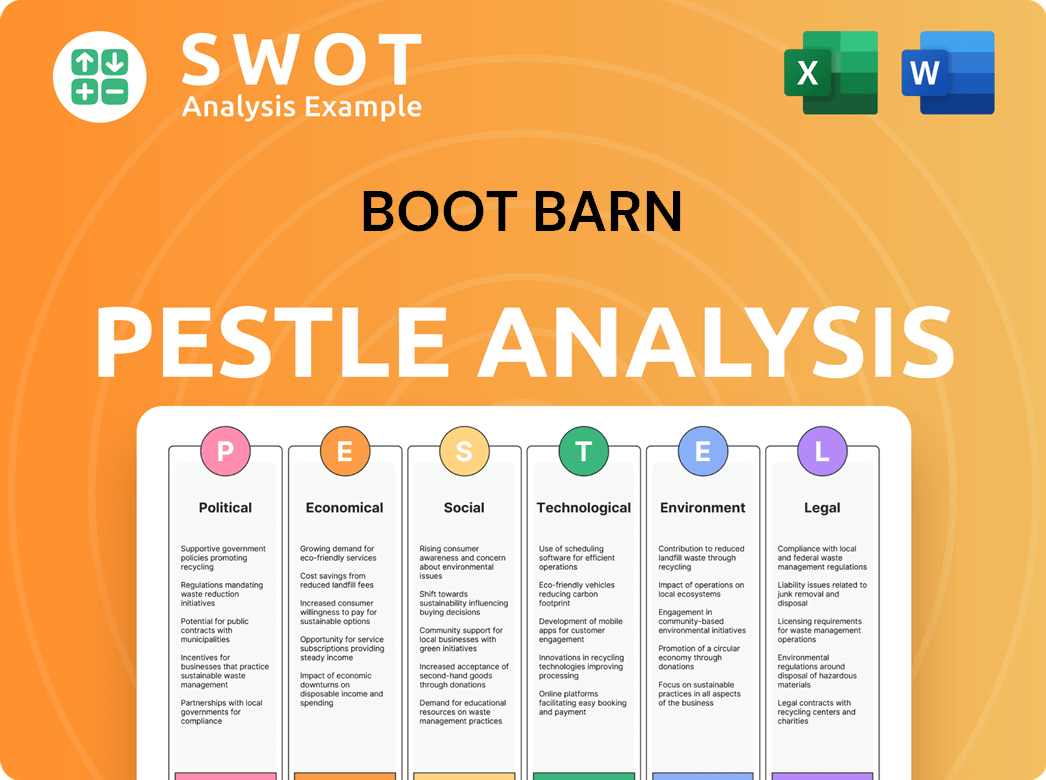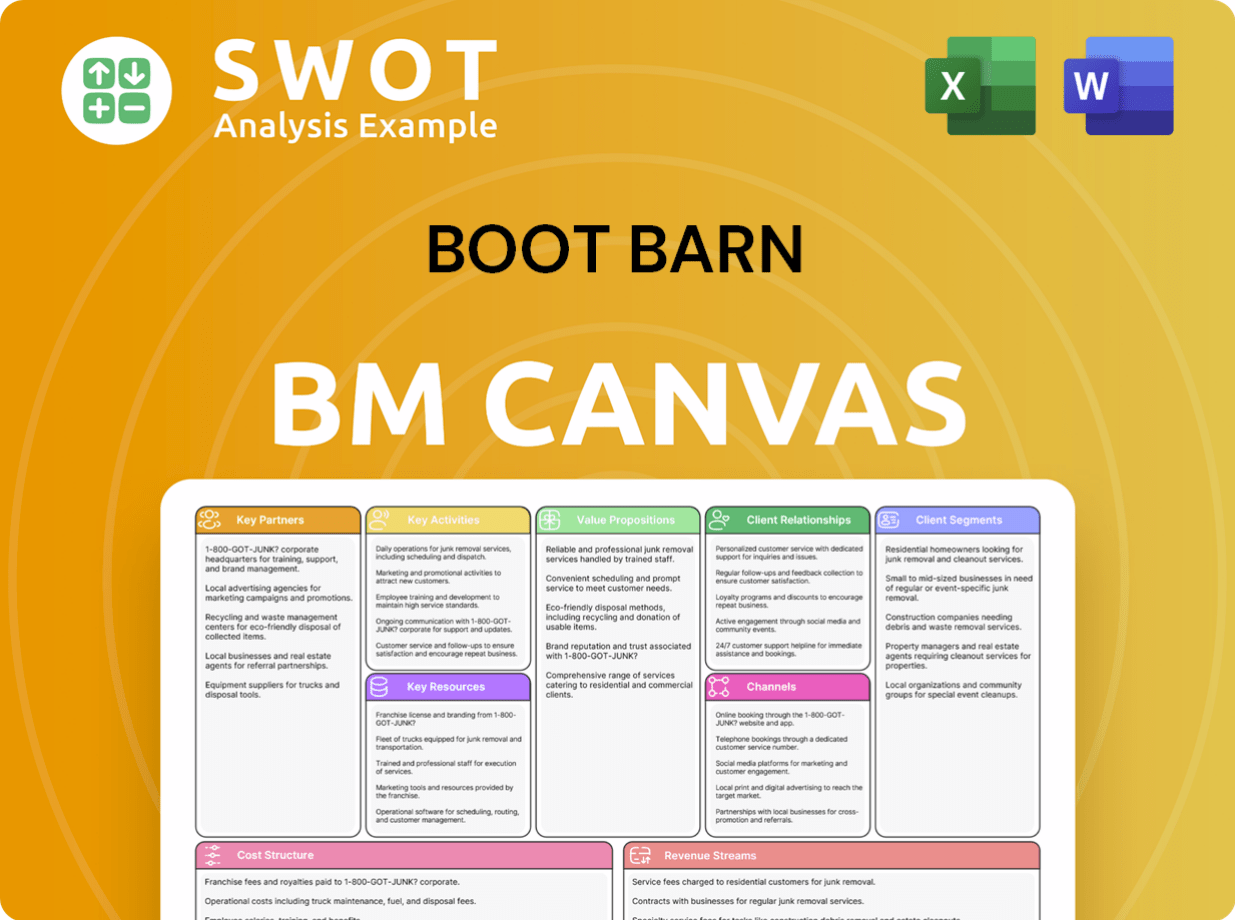Boot Barn Bundle
How Did Boot Barn Conquer the West?
Journey back in time to discover the fascinating Boot Barn SWOT Analysis and the remarkable story of Boot Barn, a retail giant that has become synonymous with Western wear and work apparel. From its humble beginnings in 1978 as a single store in Huntington Beach, California, Boot Barn has transformed into a national powerhouse. Explore the key milestones and strategic decisions that propelled this company to the forefront of the industry.

This brief history of Boot Barn reveals how a focus on quality cowboy boots, work boots, and Western wear, coupled with a commitment to customer satisfaction, fueled its impressive expansion. Learn about the Boot Barn company's evolution, from its early years to its current status as the largest western and work wear retailer, operating hundreds of stores across the nation. Uncover the secrets behind Boot Barn's enduring success and its strategic adaptation to the ever-changing retail landscape.
What is the Boot Barn Founding Story?
The story of the Boot Barn company began in 1978. It was founded by Ken Meany in Huntington Beach, California. This marked the start of what would become a significant player in the western wear retail market.
Meany's vision was to create a retail experience that celebrated the American spirit. The focus was on the western lifestyle. The company started as a single, family-run storefront. It emphasized hard work, honesty, and value.
The initial funding details are private. However, like many small businesses, it likely began with personal capital or small loans. The early days set the stage for the Boot Barn's future expansion.
The original business model focused on offering a wide range of products.
- The company offered western and work-related footwear, apparel, and accessories.
- This included a wide selection of cowboy boots, jeans, shirts, hats, and belts.
- Boot Barn aimed to serve a diverse customer base.
- The customer base included ranchers, farmers, construction workers, and those who embraced the western lifestyle.
This approach, focused on quality products and a personalized shopping experience, was key. It laid the groundwork for the company's future growth and success in the retail history.
For more insights into the company's operations, you can explore the Revenue Streams & Business Model of Boot Barn.
Boot Barn SWOT Analysis
- Complete SWOT Breakdown
- Fully Customizable
- Editable in Excel & Word
- Professional Formatting
- Investor-Ready Format

What Drove the Early Growth of Boot Barn?
The early years of the Boot Barn company were marked by steady growth and strategic expansions. This phase laid the groundwork for its future success in the Western wear market. The company navigated pivotal moments, including significant investments and acquisitions, that shaped its trajectory. These early decisions were critical in establishing the brand's presence and setting the stage for its future growth.
Initially, the company focused on expanding its retail presence in the Western states. By 2007, the company had established a network of 32 stores across three states. This early expansion was a key step in building brand recognition and market share within the Western wear sector, laying the foundation for future growth.
In 2007, the company brought in Marwit Capital as its first outside investor. This investment was crucial for driving revenue growth. Under Marwit Capital's ownership, the company experienced a remarkable increase in revenue, growing by 166%, demonstrating the impact of strategic financial partnerships.
The acquisition by Freeman Spogli & Co. in 2011 further fueled an aggressive expansion strategy. The company reached a milestone in 2012 by opening its 100th store, showcasing successful scaling across multiple states. Further expansion came through key acquisitions such as RCC Western Stores and Baskins in 2013, adding 53 stores to its portfolio.
The initial public offering (IPO) in 2014 provided access to public markets for capital. By March 30, 2024, the company had expanded its retail footprint to 400 stores across 45 states. As of May 2025, the company operated 465 stores in 49 states, marking significant growth over the years.
Boot Barn PESTLE Analysis
- Covers All 6 PESTLE Categories
- No Research Needed – Save Hours of Work
- Built by Experts, Trusted by Consultants
- Instant Download, Ready to Use
- 100% Editable, Fully Customizable

What are the key Milestones in Boot Barn history?
The Boot Barn company has achieved significant milestones throughout its history, marked by consistent growth and strategic expansions within the Western wear and Cowboy boots market. This growth trajectory reflects its resilience and adaptability in the ever-evolving retail history.
| Year | Milestone |
|---|---|
| FY2012 | Boot Barn had 86 stores, setting the stage for future expansion. |
| FY2024 | The company grew to 400 stores, demonstrating a 13.7% compound annual growth rate (CAGR). |
| August 2024 | Retail store same-store sales (SSS) showed positive monthly trends, excluding November. |
| FY2025 (Projected) | Consolidated SSS is expected to increase by 5.4% to 5.9%. |
Innovation is a key aspect of the Boot Barn's strategy, particularly in expanding its exclusive brand offerings. Exclusive brands, like Cody James, have become major contributors to the business, with three of the top five brands sold being exclusive.
As of January 2024, 38% of all Boot Barn sales were from exclusive brands. The company aims to increase this to 50% of its business, showing a strong focus on proprietary products.
Since fiscal year 2019, the company has achieved a 760 basis points expansion in merchandise margin. Approximately 33% of this growth (250 basis points) is attributed to the rising penetration of exclusive brands.
Boot Barn utilizes an omnichannel retail approach, integrating its e-commerce platform with brick-and-mortar stores. A significant 60% of its online business is touched by a store associate, indicating a strong focus on customer service.
The Boot Barn company has faced several challenges, including market downturns and intense competition. In fiscal year 2024, consolidated SSS declined by 6.2%, primarily due to a high comparison base from fiscal year 2022.
In fiscal year 2024, consolidated SSS declined by 6.2%, largely due to a tough comparison with fiscal year 2022, where SSS surged by 53.7%.
The company faces potential impacts from tariffs on pricing and consumer demand, with approximately 30% of orders from China and 25% from Mexico. Boot Barn plans to mitigate these challenges through a diversified sourcing strategy.
Boot Barn has expanded its customer base through brand partnerships with figures like Morgan Wallen and NASCAR. This strategy aims to boost brand visibility and attract new customers.
Despite these challenges, Boot Barn's revenue compared to pre-pandemic levels is up 100%, and its stock price is up 70% compared to a year ago as of June 2024.
Boot Barn Business Model Canvas
- Complete 9-Block Business Model Canvas
- Effortlessly Communicate Your Business Strategy
- Investor-Ready BMC Format
- 100% Editable and Customizable
- Clear and Structured Layout

What is the Timeline of Key Events for Boot Barn?
The Boot Barn history is marked by strategic expansions and financial growth, starting from its foundation in 1978 by Ken Meany in Huntington Beach, California. The company has seen substantial growth through acquisitions and an Initial Public Offering (IPO) in 2014. Today, it operates a vast network of stores across the United States.
| Year | Key Event |
|---|---|
| 1978 | Ken Meany establishes Boot Barn in Huntington Beach, California. |
| 2007 | Marwit Capital acquires Boot Barn, leading to increased revenue. |
| 2011 | Freeman Spogli & Co. acquires Boot Barn, initiating an aggressive expansion strategy. |
| 2012 | Boot Barn reaches 100 stores nationwide. |
| 2013 | Acquires RCC Western Stores and Baskins, expanding its presence in Texas and Louisiana. |
| 2014 | Boot Barn goes public with an IPO on the NYSE. |
| FY2024 (ending March 30, 2024) | Operates 400 stores in 45 states, with net sales of $1.655 billion. |
| Q1 FY2025 (ending June 29, 2024) | Net sales increased 10.3% to $423.4 million. |
| FY2025 (ending March 29, 2025) | Expects total sales of $1.908 billion to $1.918 billion, representing growth of 14.5% to 15.1% over the prior year. The company opened 60 new stores, bringing its total store count to 459. |
| Q1 CY2025 (ended March 29, 2025) | Revenue of $453.7 million, a 16.8% year-on-year growth. Same-store sales rose 6% year on year. |
| May 2025 | Operates over 465 stores in 49 states. |
The company plans to open 60 new stores in FY2025, including expansion into new states like Alaska, Vermont, and Rhode Island. This expansion strategy aims to increase the total store count to 49 states. Management anticipates approximately 500 additional stores, targeting 900 stores by FY2030, which is expected to contribute approximately $1.5 billion in sales.
Focus is on enhancing the omnichannel presence by integrating online and offline channels. The company aims to increase brand awareness and drive traffic to both physical stores and e-commerce platforms. The company expects sales growth to be underpinned by store openings, with new stores generating robust first-year sales volumes and achieving an impressive 60% cash-on-cash return in their first year.
The company is focused on building out its exclusive brands, with a goal to increase their contribution to sales up to 50%. This strategy aims to strengthen the brand's identity and customer loyalty. This approach is expected to drive further growth.
For the first fiscal quarter ending June 28, 2025, the company expects total sales of $483 million to $491 million, reflecting a growth of 14% to 16% over the prior-year period. These projections highlight the company's confidence in its continued expansion and strong financial performance. The company's focus remains on offering a piece of the American spirit and expanding its reach to a broader range of customers.
Boot Barn Porter's Five Forces Analysis
- Covers All 5 Competitive Forces in Detail
- Structured for Consultants, Students, and Founders
- 100% Editable in Microsoft Word & Excel
- Instant Digital Download – Use Immediately
- Compatible with Mac & PC – Fully Unlocked

Related Blogs
- What is Competitive Landscape of Boot Barn Company?
- What is Growth Strategy and Future Prospects of Boot Barn Company?
- How Does Boot Barn Company Work?
- What is Sales and Marketing Strategy of Boot Barn Company?
- What is Brief History of Boot Barn Company?
- Who Owns Boot Barn Company?
- What is Customer Demographics and Target Market of Boot Barn Company?
Disclaimer
All information, articles, and product details provided on this website are for general informational and educational purposes only. We do not claim any ownership over, nor do we intend to infringe upon, any trademarks, copyrights, logos, brand names, or other intellectual property mentioned or depicted on this site. Such intellectual property remains the property of its respective owners, and any references here are made solely for identification or informational purposes, without implying any affiliation, endorsement, or partnership.
We make no representations or warranties, express or implied, regarding the accuracy, completeness, or suitability of any content or products presented. Nothing on this website should be construed as legal, tax, investment, financial, medical, or other professional advice. In addition, no part of this site—including articles or product references—constitutes a solicitation, recommendation, endorsement, advertisement, or offer to buy or sell any securities, franchises, or other financial instruments, particularly in jurisdictions where such activity would be unlawful.
All content is of a general nature and may not address the specific circumstances of any individual or entity. It is not a substitute for professional advice or services. Any actions you take based on the information provided here are strictly at your own risk. You accept full responsibility for any decisions or outcomes arising from your use of this website and agree to release us from any liability in connection with your use of, or reliance upon, the content or products found herein.